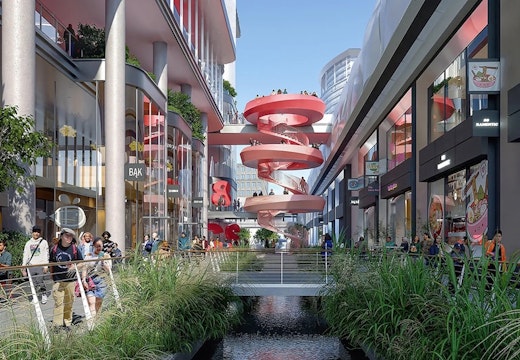Lessons from the BMW factory design that said all workers are equal
Two decades after Zaha Hadid unveiled her plans for BMW’s plant in Leipzig, which elevated the car production line over the heads of office workers, we’re still studying the message that it sent
Twenty years ago, architect Zaha Hadid put the finishing touches to her BMW factory building in Leipzig with a radical creative flourish: the car production line was extended from the manufacturing plant to run right through the administrative offices, bathed in a strange blue light.
The central idea behind this audacious design concept was to bring blue-collar and white-collar workers closer together in a single community of 750 people – the new auto models moved in an ethereal line above the desks of the professionals who pushed paper for a living instead of punching metal.

Image: BMW plant Leipzig designed by Zaha Hadid Architects
The message conveyed by this feat of architecture was unmistakeable. We are one company, BMW was saying, whether we work in production, engineering, administration or marketing.
The London advertising agency Mother was saying a similar thing when it commissioned architect Clive Wilkinson to group the entire company of 200 staff around a single, continuous concrete table inspired by a racetrack on the roof of the Fiat factory in Turin. That project was also in 2004. Again, the idea was simple: that the most senior creative director and junior account handler should share the space and the same experience, irrespective of rank and role.

Image: Mother London Office by Clive Wilkinson Architects
Policy on flexible working
Two decades on, in 2024, that message of equality of treatment across the entire workforce is even more relevant. But business leaders no longer leave it to the design of the physical building to communicate this point to employees. The messenger is more likely to be company policy on flexible working.
Have you noticed how large organisations with a mix of head office, retail, warehousing and logistics staff are mandating their laptop-toting knowledge workers back to the office, not because they can’t do their work remotely but because there needs to be parity with the people who can only perform their tasks on-site.
British health retailer and pharmacy chain Boots is one high-profile example of this trend, calling its head office staff back to the office five days per week. From Tesla to Apple, companies with high numbers of either production or retail staff, whose jobs require that they turn up at a facility every day in-person, are looking across the entire workforce for policies that are fair.
Why should professional head office staff enjoy flexible benefits that other employees will be automatically denied? The point seems clear, but company leaders appear very reluctant to talk about it directly.
Looking for fairness?
There could be two reasons for this. First, recent surveys have shown how important flexible working is to retaining premium talent. According to Gartner, a rigid return to the office will drive the highest performers out of the organisation first, closely followed by women and millennials.
Second, the core argument about a full-on return to the office made by company bosses is not typically about fairness to other colleagues – it is about culture and team bonding, which are seen as threatened by knowledge workers reluctant to abandon the comfort and convenience of home.
Senior leaders know that different parts of their global business will always operate with different conditions, which is why an Amazon fulfilment centre in Derby will be a world away from Amazon’s HQ in Seattle. So, bosses tend to bang the drum for collaborative innovation, , knowing its importance in the global economy, rather than being collegiate.
‘Zaha Hadid’s overhead line of cars has morphed from design marvel into a metaphor…’
Twenty years ago, BMW in Leipzig sent a blue-lit message to its white-collar workers through its workplace design that they were part of the same enterprise as their oily production-line colleagues. Today, that message of consistency for all employees is more likely to be sent via workplace strategy that curbs the extent of flexible working. Zaha Hadid’s overhead line of cars has thus morphed from a marvel of architectural form into a metaphor about creating unity of purpose.
As companies contemplate remodelling their workplaces to align with their hybrid working policies, BMW’s Leipzig project is still giving us something to think about.
To learn about new workplace strategies adopted by large organisations around the world, visit WORKTECH Academy’s Hybrid Working Radar in our Innovation Zone, an exclusive resource for members and partners.
Join WORKTECH Academy as a member here.








